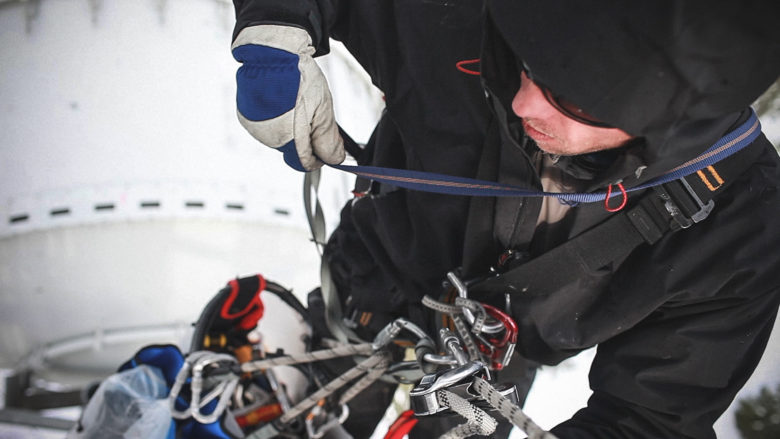Every year, there are over 50,000 “struck by falling object” recordables. Falling objects put at risk employees’ lives, productivity and the bottom line. And it’s not only heavy objects that can injure or kill someone—an object weighing only two pounds dropped from a height of 30 feet could cause major injury to someone wearing a hard hat.
It’s important for safety protocols to prevent falling tools from harming anyone or causing damage. The focus should always be on preventing the fall, not on using nets to catch the objects once they fall—these should be only be used as a secondary safety system—or on damage control after the incident. Making basic changes to engineering controls and providing employees with behavioral safety training could significantly lower the number of deaths, injuries and damages caused by falling objects.
Engineering, equipment and housekeeping
Several simple engineering and housekeeping steps can reduce the number of falling tools and objects on construction sites. For example, tethering smaller tools can secure them from striking people below if they’re dropped, and can even prevent knee-jerk reactions of workers trying to catch them.
However, any tool over five pounds should be secured to a safe, fixed structure or anchor point instead of a worker. If a tool weighing over five pounds gets loose, its weight and force could cause injury or even pull someone over a ledge. Workers should also be trained in the use of safety attachments and in the safest ways to pass tools to a colleague when working at heights.
Transporting tools in a safe manner will also reduce the likelihood that they will be dropped. There are many buckets, bags and pouches available on the market with closure systems that prevent items from falling out. If the weight of the equipment is too much for the worker to lift easily, the container should be hoisted.
Housekeeping issues can also affect the safety of the people on the ground if debris created by work is allowed to fall freely. Covered chutes provide a safe way of removing debris from the worksite without throwing items over the side of a platform or a roof. This will prevent objects from ricocheting or being dropped, minimizing the risk of harm.
When addressing housekeeping issues, it’s important to consider stray items left on platforms or roofs. They can become dislodged or kicked off, and a system of checking out tools before taking them up and then checking them back in later can ensure that no equipment is left behind.
Lastly, bad weather can cause many difficulties for outdoor work. A strong wind can blow equipment off platforms and create unsafe conditions for workers. If the weather is particularly severe, work might have to be rescheduled to prevent putting people at risk.
These engineering solutions and safety procedures need to be implemented together with training that targets the normalization of risk and complacency that naturally arises when people become comfortable with working at heights.
Complacency and normalization of risk
Normalization of risk can lead workers to ignore certain hazardous situations—like lower heights—because they don’t appear dangerous. More than 40% of fatal falls occur from 15 feet or lower, in part because, after working at great heights, smaller heights no longer appear as dangerous so it’s easy to become complacent and decide against precautions such as fall protection or ensuring three points of contact on a ladder.
This problem also applies to consistent tethering of tools. Once someone becomes used to working with a tool, complacency enters the equation and they may decide against tethering it because they never dropped it once. Or, if a tether is introduced as part of a new safety initiative, they choose to not use it because they “don’t need it”.
These are two examples of human factors—mental states that can affect how workers follow safety requirements for working at heights. There’s no instant solution to these issues. You can mandate and enforce consequences around tethering policies, but it’s not feasible to monitor and ensure compliance 100% of the time. Fortunately, human error reduction training has been shown to drastically reduce the impact that human factors have on a workplace’s overall level of safety.
Safety culture
Most people think that they are safe enough. And they never get hurt as a result of a dropped tool, so it’s important to make workers understand how their actions affect the safety of others. Clearly, primary fall protection systems are there to protect them, but workers might need reminding that the secondary systems are there to protect others. Because nobody wants to be the person that causes someone else’s death or injury.
Each worksite is a fragile safety ecosystem that requires constant care and focus. Without regular encouragement and a team spirit, it’s easy to make mistakes, ignore the rules or become complacent. A healthy safety culture limits the normalization of risk and highlights how simple actions, such as not putting a tool away safely, might affect someone’s life.
The most effective course of action is to tie engineering and human error solutions together by focusing on all hazards—physical and behavioral—present at heights. This approach will lead to fewer objects falling on unsuspecting people below and prevent injuries, fatalities, damages and financial costs.

